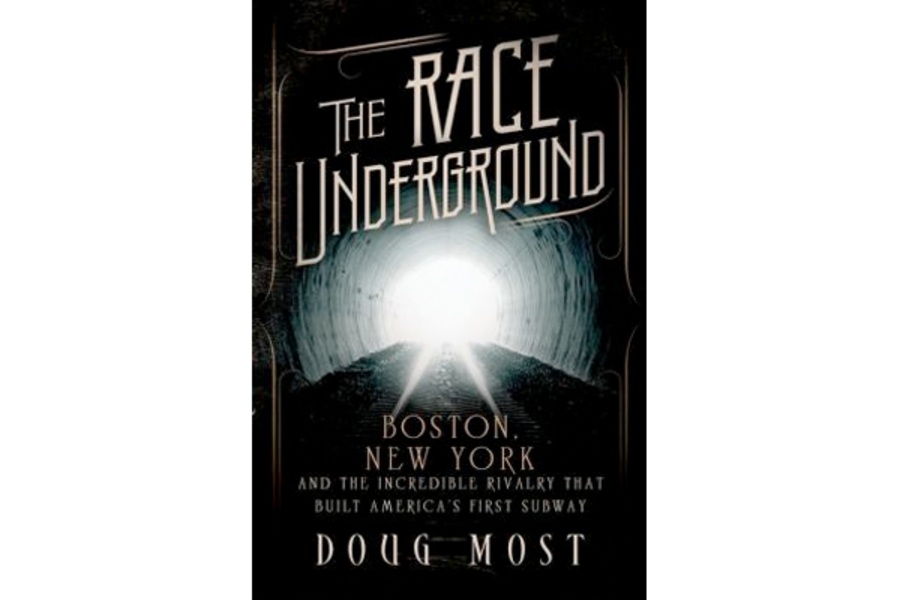The Race Underground
Loading...
The Race Underground tells the tale of two subways and the cities they transformed. It's also a treasure chest of smaller stories, about the people who fought for, and against, a subterranean answer to an urban gridlock of horse-pulled vehicles.
In the 19th century, Boston and New York were increasingly choked with traffic. Author Doug Most, deputy managing editor for features at the Boston Globe, describes how "the packed sidewalks and overcrowded streets were grinding New York to an angry standstill. On some mornings, the carriages would be forced to stand motionless for half an hour or longer."
Across the Atlantic, London offered an answer. The first subway in the world opened in 1863. But it wasn't an easy solution to embrace.
For one reason, London's underground was dirty. "[P]owered by steam ... from the very first day the tunnels were filled with dark soot, black smoke, and showers of sparks that made for an altogether miserable traveling experience."
So advocates for subways in America tasked themselves to create a system that efficiently moved people underground but wasn't filthy and uncomfortable like London's was.
Publisher/inventor Alfred Beach managed to build his own small, experimental subway, completed in 1870. But infamous politician "Boss" Tweed managed to put the brakes on Beach's early efforts to create a complete subway for New York.
Eighteen years later, inventor/businessman Frank J. Sprague staked his fortune on his ability to create an electrically powered streetcar system for Richmond, Virginia. Most tunnels deep to unearth the rich soil of 19th-century life, politics, personalities, and scientific developments such as this absorbing story of Sprague's courageous venture to show that urban transportation could, and should, be powered by electricity.
So readers must grip the strap and enjoy the ride. It's possible early on to wonder how these vivid descriptions will lead to Most's destination: the race to build the first subway. But Most's narrative gains momentum and focus with the introduction of two brothers – Henry and William Whitney.
They grew up west of Boston. Younger brother William became a powerful, respected and extremely wealthy businessman in New York. Deeply involved in politics, he was a confidant of President Grover Cleveland and served as his Secretary of the Navy.
Older brother Henry moved to Boston, also becoming a successful businessman, and in 1887 marshaled his resources and political influence to persuade Massachusetts lawmakers to allow him to consolidate and take control of Boston's street railways. Furthermore, in a big step toward building America's first subway, they also gave him permission to tunnel under Boston.
Meanwhile, William, as point man for a group of investors, also consolidated New York's chaotic streetcar system. Like his brother, William could have pushed New York to electrify its streetcars and to build a subway – but he doesn't.
So William misses an opportunity to lead New York underground. And Henry steps back and lets others, including Boston Mayor Nathan Matthews, take the reins.
Boston starts to dig in March 1895. Most takes this faded construction daguerreotype and fills it with color and action. He describes workers digging up history – a piece of a Revolutionary War cannon, the grim remnants of a cemetery – and through a dangerous mess of water and gas pipes. They worked carefully, but not carefully enough to avoid a disastrous explosion at the busy corner of Tremont and Boylston streets. But on September 1, 1897, the first three sections of Boston's subway opened in an celebratory city.
Finally, New York, after years of debate and failed attempts to arrive at a winning plan, broke ground in March 1900. "In a matter of days . . . it looked like bombs had exploded all over the city. . . . [S]treets were reduced to rubble."
But they had begun. Most describes how "four thousand tons of steel rails lay end to end wherever there was a tunnel underground." And then the rails would disappear "as if a monster from beneath the surface was gobbling them up one by one." In October 1904, seven years after Boston, New York opened its subway.
Today, Boston's quirky and sometimes twisty "T" continues to offer a crucial alternative to its quirky and sometimes twisty streets. Meanwhile, New York's hugely larger MTA offers a loopy grid of lines taking passengers to an extraordinary panorama of places.
So fundamental are these subways to each city's infrastructure, it can seem like they've always been there. Except they haven't, and Doug Most abundantly provides the colorful details of a drama that transformed these two great cities.
David Hugh Smith hops on the "T" in Brookline, Mass., a "streetcar suburb" reshaped by Henry Whitney, who also lived in this next-to-Boston community.








